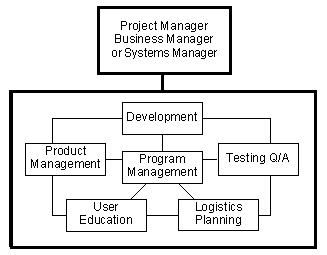
To make the team model's "team of peers" concept work, you need to understand and support the roles and dynamics of the team members. Rather than being directly responsible for the day-to-day project direction and tracking, the project manager becomes a facilitator. Depending on the corporate structure, this manager might be the designated Project Manager, Business Manager, or Information Systems Manager.
The following diagram illustrates an overall project structure that includes the suggested project team roles.
Project reporting structure

The Project Management team includes the Project Manager and the individual leads for each of the team roles. They share the responsibility for planning schedules and resources, assessing risks, and tracking the project. Because each team must deliver on its commitment by completing a set of tasks, each lead should participate in project planning and management. The following items describe examples of this participation.
When necessary, the Project Manager may make top-down decisions if the team members cannot reach consensus. Obviously, this can have a tendency to migrate gradually to a more traditional top-down project management style. Only the corporate culture can assure that it will not.